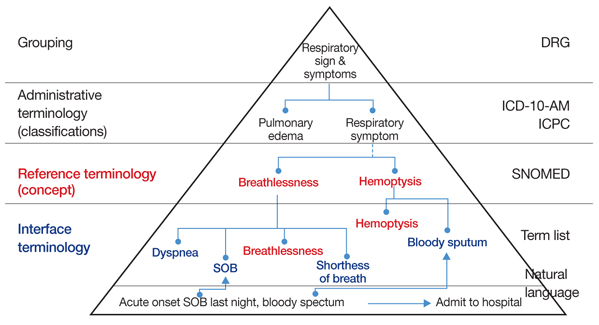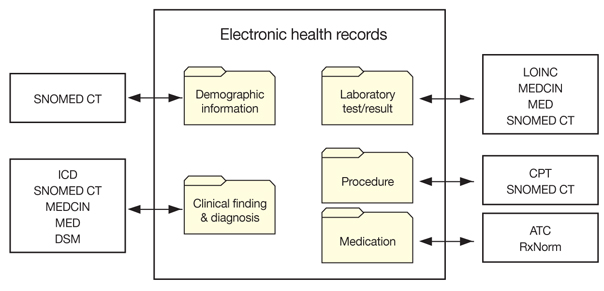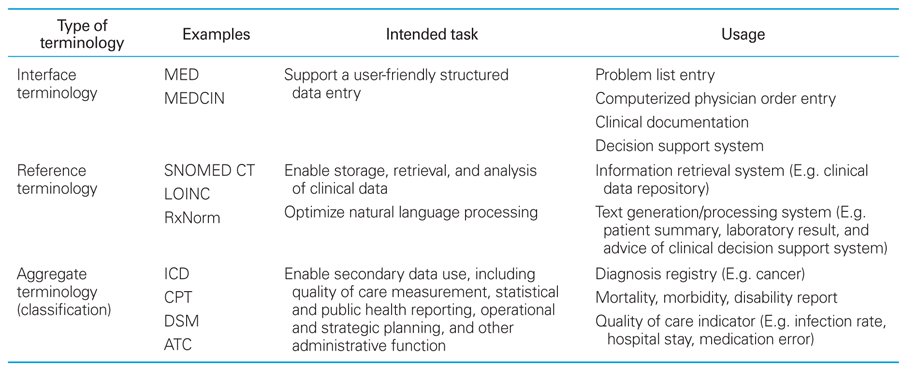 |
 |
- Search
| J Korean Med Assoc > Volume 55(8); 2012 > Article |
Abstract
Around the world electronic health records data are being shared and exchanged between two different systems for direct patient care, as well as for research, reimbursement, quality assurance, epidemiology, public health, and policy development. It is important to communicate the semantic meaning of the clinical data when exchanging electronic health records data. In order to achieve semantic interoperability of clinical data, it is important not only to specify clinical entries and documents and the structure of data in electronic health records, but also to use clinical terminology to describe clinical data. There are three types of clinical terminology: interface terminology to support a user-friendly structured data entry; reference terminology to store, retrieve, and analyze clinical data; and classification to aggregate clinical data for secondary use. In order to use electronic health records data in an efficient way, healthcare providers first need to record clinical content using a systematic and controlled interface terminology, then clinical content needs to be stored with reference terminology in a clinical data repository or data warehouse, and finally, the clinical content can be converted into a classification for reimbursement and statistical reporting. For electronic health records data collected at the point of care to be used for secondary purposes, it is necessary to map reference terminology with interface terminology and classification. It is necessary to adopt clinical terminology in electronic health records systems to ensure a high level of semantic interoperability.
References
1. Chaudhry B, Wang J, Wu S, Maglione M, Mojica W, Roth E, Morton SC, Shekelle PG. Systematic review: impact of health information technology on quality, efficiency, and costs of medical care. Ann Intern Med 2006;144:742-752.
2. Institute of Electrical and Electronics Engineers Computer Society. Standards Coordinating Committee. IEEE standard computer dictionary: a compilation of IEEE standard computer glossaries 1990;New York: Institute of Electrical and Electronics Engineers.
3. Veltman KH. Syntactic and semantic interoperability: new approaches to knowledge and the semantic web. New Rev Inf Netw 2001;7:159-183.
4. Garde S, Knaup P, Hovenga E, Heard S. Towards semantic interoperability for electronic health records. Methods Inf Med 2007;46:332-343.
5. Kalra D, Musen M, Smith B, Ceusters W, De Moor G. ARGOS policy brief on semantic interoperability. Stud Health Technol Inform 2011;170:1-15.
6. Kalra D. Electronic health record standards. Yearb Med Inform 2006;136-144.
7. Dolin RH, Alschuler L, Boyer S, Beebe C, Behlen FM, Biron PV, Shabo Shvo A. HL7 Clinical Document Architecture, Release 2. J Am Med Inform Assoc 2006;13:30-39.
8. Martinez-Costa C, Menarguez-Tortosa M, Fernandez-Breis JT. An approach for the semantic interoperability of ISO EN 13606 and OpenEHR archetypes. J Biomed Inform 2010;43:736-746.
9. Dolin RH, Giannone G, Schadow G. Enabling joint commission medication reconciliation objectives with the HL7 / ASTM Continuity of Care Document standard. AMIA Annu Symp Proc 2007;186-190.
10. Chute CG. Clinical classification and terminology: some history and current observations. J Am Med Inform Assoc 2000;7:298-303.
11. Yun JH, Kim MJ, Ahn SJ, Kwak MS, Kim Y, Kim HK. The Development of clinical terminology dictionary for integration and management of clinical terminologies in EMR systems. J Korean Soc Med Inform 2009;15:411-421.
12. Scott P, Macisaac P, Saad P. National Centre for Classification in Health. An introduction to health terminologies 2002;Brisbane: National Centre for Classification in Health.
13. Rosenbloom ST, Miller RA, Johnson KB, Elkin PL, Brown SH. Interface terminologies: facilitating direct entry of clinical data into electronic health record systems. J Am Med Inform Assoc 2006;13:277-288.
14. Rector AL. Thesauri and formal classifications: terminologies for people and machines. Methods Inf Med 1998;37:501-509.
15. World Health Organization. International Classification of Diseases (ICD) [Internet] cited 2012 Jun 20. Geneva: World Health Organization. Available from: http://www.who.int/classifications/icd/en
16. International Health Terminology Standards Development Organisation. SNOEMD clinical terms [Internet] cited 2012 Jun 20. Copenhagen: International Health Terminology Standards Development Organisation. Available from: http://www.ihtsdo.org/snomed-ct
17. Logical Observation Identifiers Names and Codes. Logical Observation Identifiers Names and Codes (LOINC) [Internet] cited 2012 Jun 20. Indianapolis: Logical Observation Identifiers Names and Codes. Available from: http://loinc.org
18. American Medical Association. CPT-current procedural terminology [Internet] cited 2012 Jun 20. Chicago: American Medical Association. Available from: http://www.ama-assn.org/ama/pub/physician-resources/solutions-managing-your-practice/coding-billing-insurance/cpt.page
19. Almqvist C, Wettermark B, Hedlin G, Ye W, Lundholm C. Antibiotics and asthma medication in a large register-based cohort study - confounding, cause and effect. Clin Exp Allergy 2012;42:104-111.
20. Liu S, Ma W, Moore R, Ganesan V, Nelson S. RxNorm: prescription for electronic drug information exchange [Internet] 2005;cited 2012 Jul 1. Washington, DC: IEEE Computer Society. Available from: http://165.112.140.110/research/umls/rxnorm/RxNorm.pdf
21. Foley MM, Garrett GS. key issues shaping clinical terminology and classification. J AHIMA 2006;77:24-28. 30.
22. Chiang MF, Casper DS, Cimino JJ, Starren J. Representation of ophthalmology concepts by electronic systems: adequacy of controlled medical terminologies. Ophthalmology 2005;112:175-183.
23. Qureshi AI, Harris-Lane P, Siddiqi F, Kirmani JF. International classification of diseases and current procedural terminology codes underestimated thrombolytic use for ischemic stroke. J Clin Epidemiol 2006;59:856-858.
Figure 1
Relationship between interface, reference and aggregate terminologies (From Scott P, et al. An introduction to health terminologies. Lidcombe: National Centre for Classification in Health; 2002) [12]. DRG, diagnosis-related group; ICD-10-AM, International Classification of Diseases, Tenth Revision, Australian Modification; ICPC, International Classification of Primary Care; SNOMED, Systematized Nomen-Clature of Medicine.

Figure 2
Use of terminology in electronic health records. SNOMED CT, Systematized Nomenclature of Medicine Clinical Terms; ICD, International Classification of Diseases; MED, Medical Entities Dictionary; DSM, Diagnostic and Statistical Manual of Mental Disorders; LOINC, Logical Observation Identifiers Names and Codes; CPT, Current Procedural Terminologies; ATC, Anatomical Therapeutic Chemical Classification System.

Table 1
Intended task and usage by clinical terminology types

MED, medical entities dictionary; SNOMED CT, Systematized Nomenclature of Medicine Clinical Terms; LOINC, Logical Observation Identifiers Names and Codes; ICD, International Classification of Diseases; CPT, Current Procedural Terminologies; DSM, Diagnostic and Statistical Manual of Mental Disorders; ATC, Anatomical Therapeutic Chemical Classification System.






